The Law Label was introduced in the early 1900s to inform consumers about the filling materials hidden inside furniture and the beddings. It’s a tag that is attached to a product that provides consumers with information such as product ingredients (including filled ingredients and their percentages) and manufacturers or importers or sellers.
Where's Law Label Applied?
There are currently two countries with this requirement: the United States and Canada. In both countries, labeling requirements vary by state or province. However, a Uniform Law Label can be produced to meet the different requirements across all states and provinces.
In the U.S., Law Labels are regulated by various departments, including the Department of Health, Weights & Measures, Bureau of Home Furnishings, Department of Agriculture, and the Division of Industrial Compliance. In Canada, the Fair Business Practices Branch of Industry Canada administers the federal Textile Labelling Act, which regulates the labeling, sale, importation, and advertising of consumer textile articles, including upholstered furniture.
URN and CA Numbers in Law Label
Law Labels in most states require the display of a Uniform Registry Number (URN) in the U.S. and a CA Number in Canada. The URN and CA Number identify the manufacturing facility that produced the product. This facility can be located anywhere in the world, as long as its products are sold in the U.S. or Canada.
V-Trust has extensive experience in quality control services, including the inspection of furniture, bedding, household products, and other items shipped to the U.S., Canada, and beyond. As a result, we are well-versed in labeling regulations in these markets, ensuring full compliance with all relevant requirements.
Example of Label Format Valid in the US:
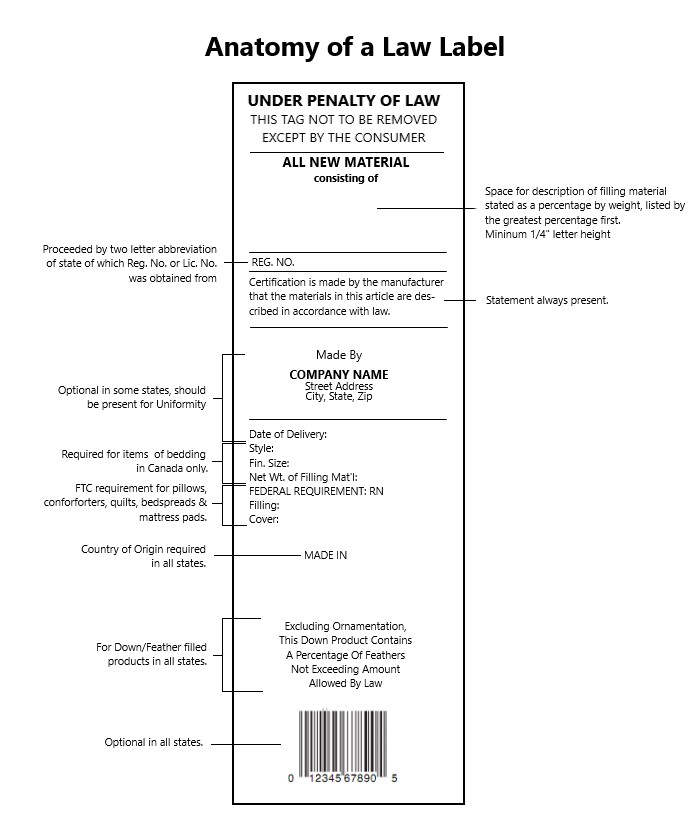
Source: American Law Label, Inc.
Notes:
- The content on the label must be in English, black on white, minimum size is 2 inches width x 3 inches height, minimum font is 1/8" in height or not less than 9 point type.
- "Name and address of ...", can be expressed in the following formats:
MADE BY....... (List the manufacturer), or MADE FOR....... (List the Importer or Distributer), or SOLD BY...... (List the Retailer) - The lines separating text content must be extended to the edge of the legal label (see picture below).
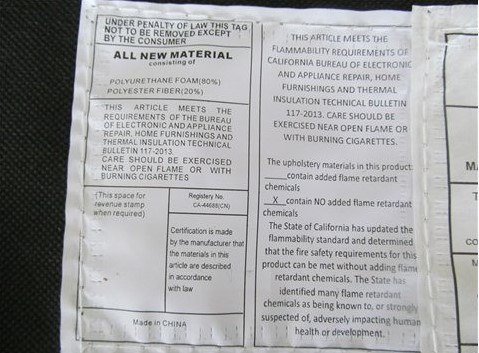
- The legal label's 3-inch height requirement starts with the initials of the word "UNDER" and ends with the origin information at the bottom of the legal label.
- The format requirements for the font height, acronym, bold printing and capital letters of several parts are put forward. For example, "ALL NEW MATERIAL" must be in capital letters and the entire portion must be printed in bold; There are no formatting requirements for certified content such as "Certification is made..." and there are no formatting requirements except for the origin fonts, which must be all in capital letters, bold prints, 1/8 inches in height, and no formatting requirements.
- Examples illustrate how the legal label for a padded furniture product indicates the availability of flame retardants as required by California SB 1019. SB 1019 requires all padded furniture manufacturers who comply with TB117-2013 to indicate on the furniture whether they contain flame retardants. The Act entered into force on 1 January 2015.The International Association of Bedding and Furniture Legal Officers (IABFLO) has updated its legal labeling requirements for bedding and furniture products sold in the United States, a joint proposal by U.S. states and it’s now in effect.
- In addition, if the goods are exported to California, for padded furniture manufactured after 1 January 2015, add the TB 117 plus SB 1019 fire proof label (Flammability Label), see the following example or annex picture (Law Label and Flammability Label are separated by thick black line):
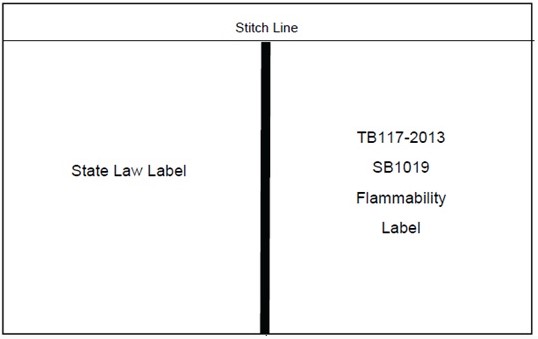
Or
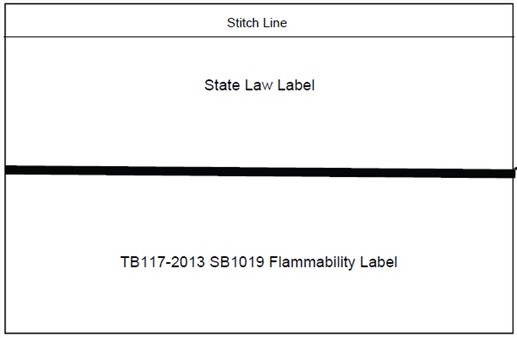
Note: According to market practice, such goods exported to the United States, whether sold in California or not, will usually be added to this Flammability Label to avoid legal risks.
- Flammability Label is as follows:
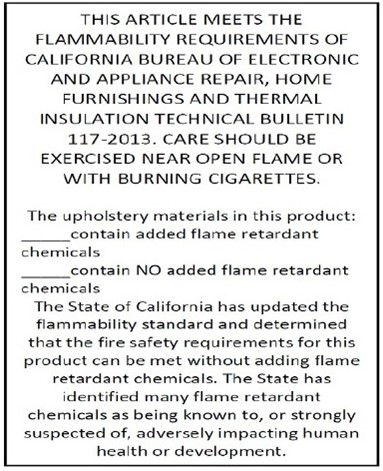
Example of Label Format Valid in Canada:
Canadian Market (TSSA Form 1, as follows):
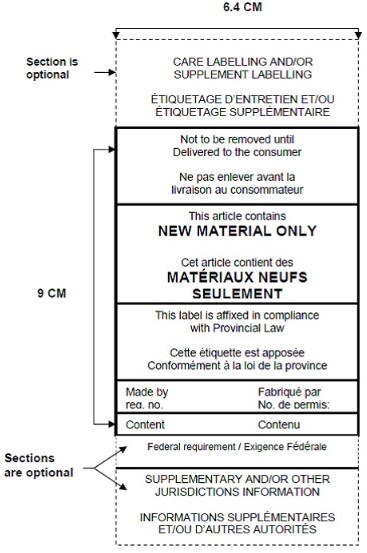
Notes:
According to the Textile Labelling Act, the fiber content of the outer covering fabric is required to be shown:
- By the generic name of each fiber that is present in an amount of 5% or more by weight. Fibers present in amounts of less than 5% require disclosure as "other fiber(s)" or by their generic name. If the fiber content is not known, it may be declared as "100% unknown fibers".
- As a percentage, in descending order by weight. Alternatively, a preprinted label may be used with fibers listed in alphabetical order and percentages inserted for fibers which are present.
- On a label that is applied to the article so that it is readily accessible to the prospective customer (i.e., not flat on the underside of a large piece). The label may be permanently attached or non‑permanent, such as a hang tag or sticker.
- The fiber content information is required to be bilingual unless the article is sold in an area where only one official language is used by consumers when making purchases.
Quality Control: Ensuring Law Label Compliance
Importers are responsible for meeting regulatory requirements when bringing these products into the U.S. and Canadian markets. To prevent shipments from being denied entry due to labeling discrepancies, the following quality control measures should be implemented:
- Be knowledgeable about US and Canada’s labelling requirements;
- Ensure that all shipments are labelled in accordance with their order;
- Discuss quality control measures with your suppliers to ensure their methods provide adequate safeguards for accuracy;
- Track fiber content quality routinely through in-house sampling or laboratory testing.
V-Trust has a solid history in helping overseas importers ensure their products meet quality standards and in compliance with market regulations.
For more information concerning quality control and regulations, please feel free to contact us at info@v-trust.com
Recommended:
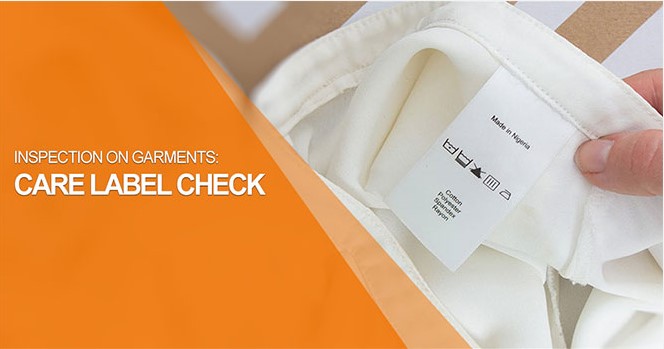 |
Care Label Check in Garment Inspections It is not very uncommon for us in the quality control industry to come across situations which importers (mostly inexperienced) do not fully understand cross-border regulations on care labels and its importance to consumers’ satisfaction with the product they are buying. |




内容